warning light OPEL ANTARA 2017.5 Manual user
[x] Cancel search | Manufacturer: OPEL, Model Year: 2017.5, Model line: ANTARA, Model: OPEL ANTARA 2017.5Pages: 225, PDF Size: 6.2 MB
Page 13 of 225

In brief111Side air vents .....................119
2 Fixed air vents .................... 120
3 High beam .......................... 106
Headlight flash ...................106
Turn and lane-change
signals ................................ 108
Exit lighting ......................... 112
Parking lights .....................109
Cruise control ....................... 91
4 Remote control on
steering wheel ......................72
Trip computer .....................100
5 Horn ..................................... 72
6 Instruments .......................... 78
Driver Information Centre ...... 91
7 Windscreen wiper and
washer system, headlight
washer system .....................73
Rear window wiper and
washer system .....................748Info-Display .......................... 94
Check control, tyre
pressure monitoring
system ................................ 183
Trip computer .....................100
9 Centre air vents .................. 119
10 Hazard warning flashers ....107
Parking assist ..................... 148
Electronic Stability Control . 145
Descent control system ...... 146
Status LED for anti-theft
alarm system ........................ 26
Folding exterior mirrors ........29
Fuel economy mode ...........122
11 Infotainment system .............10
12 Front passenger airbag ........48
13 Status LEDs for front
passenger airbag .................50
Control indicator for front
passenger seat belt .............42
14 Glovebox .............................. 57
15 Fuse box ............................ 17616Climate control system ....... 114
17 Ignition switch with
steering wheel lock ............125
18 Accelerator pedal ...............124
19 Driver airbag ........................ 48
20 Brake pedal ........................ 142
21 Clutch pedal ....................... 123
22 Steering wheel adjustment ..72
23 Bonnet release ...................158
24 Coin storage ......................... 56
25 Card holder .......................... 56
26 Light switch ........................ 105
Automatic light control .......106
Instrument illumination .......110
Rear fog light ...................... 109
Front fog lights ...................108
Headlight range
adjustment ......................... 106
Page 28 of 225
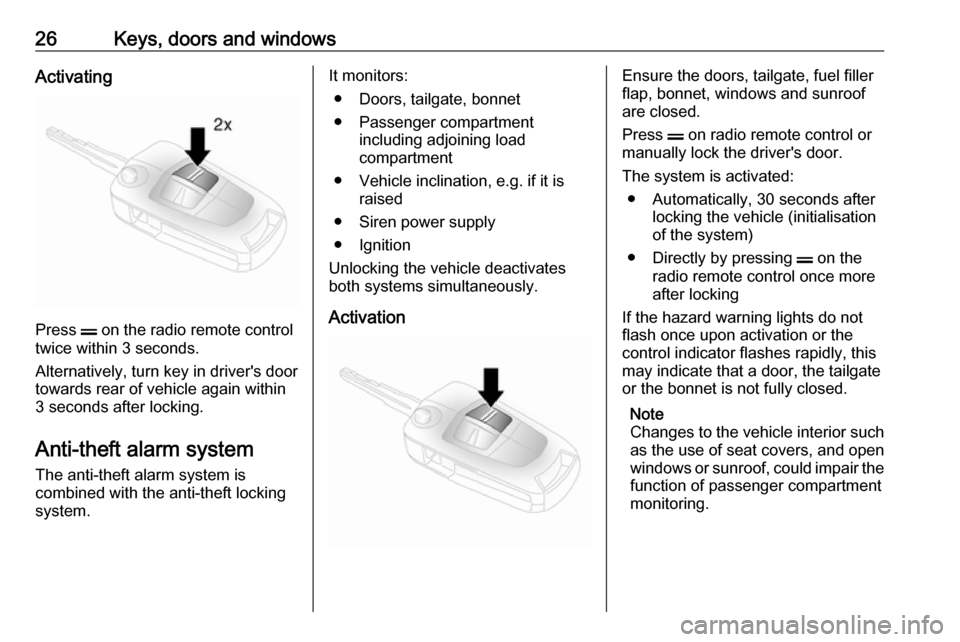
26Keys, doors and windowsActivating
Press p on the radio remote control
twice within 3 seconds.
Alternatively, turn key in driver's door
towards rear of vehicle again within
3 seconds after locking.
Anti-theft alarm system The anti-theft alarm system is
combined with the anti-theft locking
system.
It monitors:
● Doors, tailgate, bonnet
● Passenger compartment including adjoining load
compartment
● Vehicle inclination, e.g. if it is raised
● Siren power supply
● Ignition
Unlocking the vehicle deactivates both systems simultaneously.
ActivationEnsure the doors, tailgate, fuel filler
flap, bonnet, windows and sunroof
are closed.
Press p on radio remote control or
manually lock the driver's door.
The system is activated: ● Automatically, 30 seconds after locking the vehicle (initialisation
of the system)
● Directly by pressing p on the
radio remote control once more
after locking
If the hazard warning lights do not flash once upon activation or the
control indicator flashes rapidly, this
may indicate that a door, the tailgate
or the bonnet is not fully closed.
Note
Changes to the vehicle interior such
as the use of seat covers, and open
windows or sunroof, could impair the
function of passenger compartment
monitoring.
Page 29 of 225
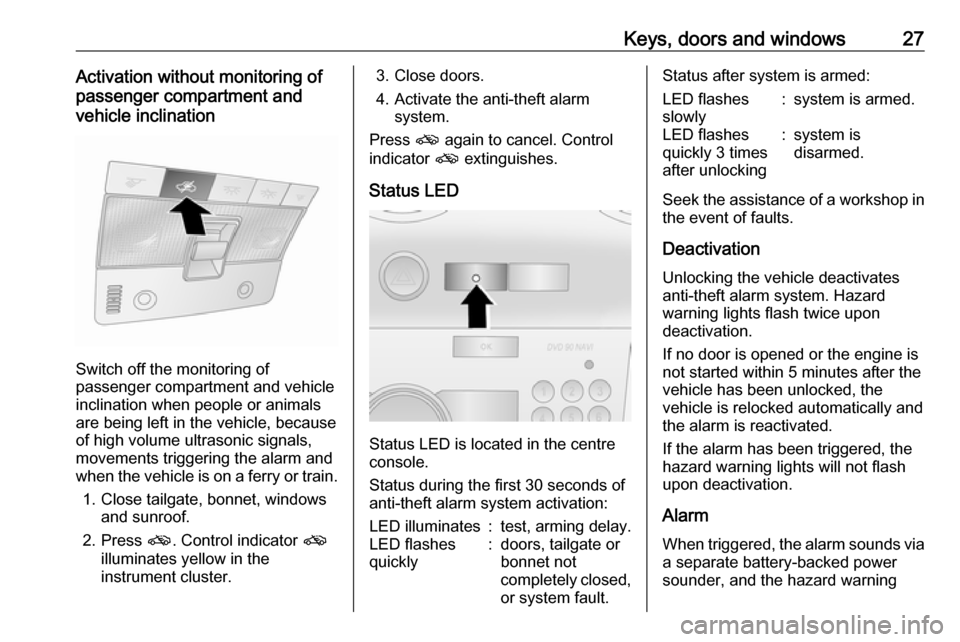
Keys, doors and windows27Activation without monitoring of
passenger compartment and
vehicle inclination
Switch off the monitoring of
passenger compartment and vehicle
inclination when people or animals
are being left in the vehicle, because
of high volume ultrasonic signals,
movements triggering the alarm and
when the vehicle is on a ferry or train.
1. Close tailgate, bonnet, windows and sunroof.
2. Press o. Control indicator o
illuminates yellow in the
instrument cluster.
3. Close doors.
4. Activate the anti-theft alarm system.
Press o again to cancel. Control
indicator o extinguishes.
Status LED
Status LED is located in the centre
console.
Status during the first 30 seconds of
anti-theft alarm system activation:
LED illuminates:test, arming delay.LED flashes
quickly:doors, tailgate or
bonnet not
completely closed,
or system fault.Status after system is armed:LED flashes
slowly:system is armed.LED flashes
quickly 3 times
after unlocking:system is
disarmed.
Seek the assistance of a workshop in
the event of faults.
Deactivation
Unlocking the vehicle deactivates
anti-theft alarm system. Hazard
warning lights flash twice upon
deactivation.
If no door is opened or the engine is
not started within 5 minutes after the
vehicle has been unlocked, the
vehicle is relocked automatically and
the alarm is reactivated.
If the alarm has been triggered, the
hazard warning lights will not flash
upon deactivation.
AlarmWhen triggered, the alarm sounds via
a separate battery-backed power
sounder, and the hazard warning
Page 35 of 225
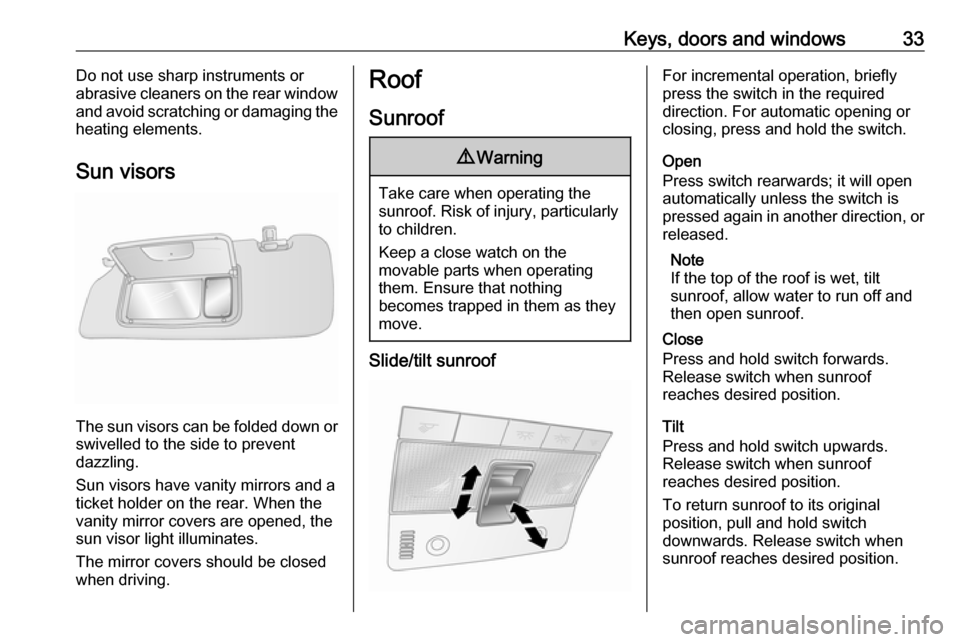
Keys, doors and windows33Do not use sharp instruments or
abrasive cleaners on the rear window
and avoid scratching or damaging the
heating elements.
Sun visors
The sun visors can be folded down orswivelled to the side to prevent
dazzling.
Sun visors have vanity mirrors and a
ticket holder on the rear. When the
vanity mirror covers are opened, the
sun visor light illuminates.
The mirror covers should be closed
when driving.
Roof
Sunroof9 Warning
Take care when operating the
sunroof. Risk of injury, particularly to children.
Keep a close watch on the
movable parts when operating
them. Ensure that nothing
becomes trapped in them as they
move.
Slide/tilt sunroof
For incremental operation, briefly
press the switch in the required
direction. For automatic opening or
closing, press and hold the switch.
Open
Press switch rearwards; it will open
automatically unless the switch is
pressed again in another direction, or
released.
Note
If the top of the roof is wet, tilt
sunroof, allow water to run off and
then open sunroof.
Close
Press and hold switch forwards.
Release switch when sunroof
reaches desired position.
Tilt
Press and hold switch upwards.
Release switch when sunroof
reaches desired position.
To return sunroof to its original
position, pull and hold switch
downwards. Release switch when
sunroof reaches desired position.
Page 38 of 225
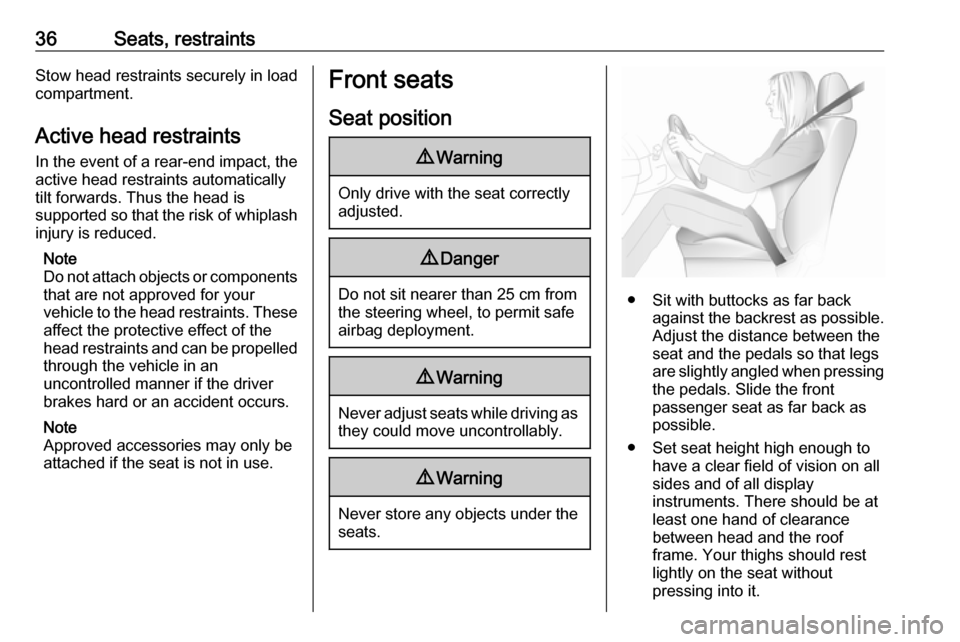
36Seats, restraintsStow head restraints securely in load
compartment.
Active head restraints
In the event of a rear-end impact, the active head restraints automatically
tilt forwards. Thus the head is
supported so that the risk of whiplash
injury is reduced.
Note
Do not attach objects or components that are not approved for your
vehicle to the head restraints. These
affect the protective effect of the
head restraints and can be propelled
through the vehicle in an
uncontrolled manner if the driver
brakes hard or an accident occurs.
Note
Approved accessories may only be
attached if the seat is not in use.Front seats
Seat position9 Warning
Only drive with the seat correctly
adjusted.
9 Danger
Do not sit nearer than 25 cm from
the steering wheel, to permit safe
airbag deployment.
9 Warning
Never adjust seats while driving as
they could move uncontrollably.
9 Warning
Never store any objects under the
seats.
● Sit with buttocks as far back against the backrest as possible.
Adjust the distance between the
seat and the pedals so that legs
are slightly angled when pressing the pedals. Slide the front
passenger seat as far back as
possible.
● Set seat height high enough to have a clear field of vision on allsides and of all display
instruments. There should be at
least one hand of clearance
between head and the roof
frame. Your thighs should rest
lightly on the seat without
pressing into it.
Page 39 of 225
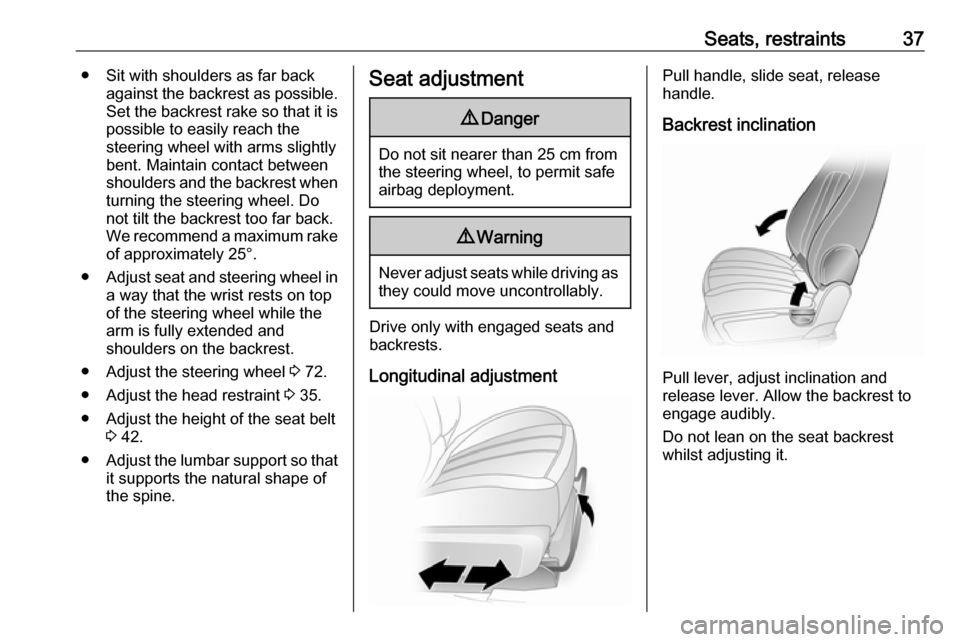
Seats, restraints37● Sit with shoulders as far backagainst the backrest as possible.
Set the backrest rake so that it is possible to easily reach the
steering wheel with arms slightly
bent. Maintain contact between
shoulders and the backrest when turning the steering wheel. Do
not tilt the backrest too far back.
We recommend a maximum rake of approximately 25°.
● Adjust seat and steering wheel in
a way that the wrist rests on top
of the steering wheel while the
arm is fully extended and
shoulders on the backrest.
● Adjust the steering wheel 3 72.
● Adjust the head restraint 3 35.
● Adjust the height of the seat belt 3 42.
● Adjust the lumbar support so that
it supports the natural shape of
the spine.Seat adjustment9 Danger
Do not sit nearer than 25 cm from
the steering wheel, to permit safe
airbag deployment.
9 Warning
Never adjust seats while driving as
they could move uncontrollably.
Drive only with engaged seats and
backrests.
Longitudinal adjustment
Pull handle, slide seat, release
handle.
Backrest inclination
Pull lever, adjust inclination and
release lever. Allow the backrest to
engage audibly.
Do not lean on the seat backrest
whilst adjusting it.
Page 51 of 225

Seats, restraints49The side airbag system consists of an
airbag in each front seat backrest.
This can be identified by the word
AIRBAG .
The side airbag system is triggered in
the event of a side impact of a certain severity. The ignition must be
switched on.
The inflated airbags cushion the
impact, thereby considerably
reducing the risk of injury to the upper body and pelvis in the event of a side-
on collision.
9 Warning
Keep the area in which the airbag
inflates clear of obstructions.
Note
Only use protective seat covers that have been approved for the vehicle.Be careful not to cover the airbags.
Curtain airbag system
The curtain airbag system consists of an airbag in the roof frame on each
side. This can be identified by the
word AIRBAG on the roof pillars.
The curtain airbag system is triggered
in the event of a side-on impact of a
certain severity. The ignition must be
switched on.
The inflated airbags cushion the
impact, thereby considerably
reducing the risk of injury to the head in the event of a side-on impact.
9 Warning
Keep the area in which the airbag
inflates clear of obstructions.
The hooks on the handles in the
roof frame are only suitable for
hanging up light articles of
clothing, without coat hangers. Do not keep any items in these
clothes.
Page 69 of 225

Storage67Raise the release lever and hold. Lift
the system slightly and push it into the
bumper until it engages.
Release lever must return to original
position.9 Warning
If the system cannot be correctly
engaged, please seek the
assistance of a workshop.
Load compartment
Storage compartments in the load compartment
Located on both sides of the load
compartment floor.
Load compartment cover
Do not place any objects on the cover.
Closing the cover
Pull load compartment cover towards rear of vehicle using handle and insert
retainers into brackets on either side
of load compartment.
Opening the cover
Remove load compartment cover
from side brackets. The cover rolls up automatically.
Page 71 of 225

Storage69Caution
Do not allow objects to protrude
above the top of the rear floor
storage compartment, to avoid
damage to the storage area and
the load compartment floor.
Jack and vehicle tools 3 179.
Tyre repair kit 3 187.
Temporary spare wheel 3 193.
Lashing eyes
The lashing eyes are designed to
secure items against slippage, e.g.
using lashing straps or a luggage floor
net.
Two additional lashing eyes are
located in front of the rear seats.
Designed for carrying small, light
items only, a luggage floor net helps
keep loads from moving during sharp turns or quick starts and stops.
To install: attach the four net hooks to
the lashing eyes mounted on the load
compartment floor.
Warning triangle Stow the warning triangle below the
floor cover in the load compartment.
First aid kit Stow the first aid kit below the floorcover in the load compartment.
Fire extinguisher Stow the fire extinguisher securely in
the load compartment.Roof rack system
Roof rack
For safety reasons and to avoid
damage to the roof, the vehicle
approved roof rack system is
recommended. For further
information contact a workshop.
Fasten the roof rack to the roof rails
following the instructions that
accompany the system, ensuring that
the roof load is evenly distributed over the side or cross rails.
Loads must not be placed on the roof
surface. To prevent damage or loss,
check frequently that roof loads are
securely fastened.
Driving with a roof load affects the
vehicle centre of gravity; drive
carefully in crosswinds and do not
drive at high speeds.
Remove the roof rack when not in
use.
Page 73 of 225

Instruments and controls71Instruments and
controlsControls ....................................... 72
Steering wheel adjustment ........72
Steering wheel controls .............72
Horn ........................................... 72
Windscreen wiper/washer .........73
Rear window wiper/washer .......74
Outside temperature ..................75
Clock ......................................... 75
Power outlets ............................. 77
Warning lights, gauges and indi‐ cators ........................................... 78
Instrument cluster ......................78
Speedometer ............................. 78
Odometer .................................. 78
Trip odometer ............................ 79
Tachometer ............................... 79
Fuel gauge ................................ 79
Service display .......................... 80
Transmission display .................80
Control indicators ......................80
Turn signal ................................. 83
Seat belt reminder .....................83
Airbag and belt tensioners .........83
Airbag deactivation ....................83Charging system .......................84
Malfunction indicator light ..........84
Service vehicle soon .................84
Brake system ............................. 85
Electrical parking brake .............85
Electrical parking brake fault .....85
Antilock brake system (ABS) .....85
Upshift ....................................... 86
All wheel drive ........................... 86
Sport mode ................................ 86
Descent control system .............86
Power steering .......................... 86
Ultrasonic parking assist ...........87
Electronic Stability Control ........87
Electronic Stability Control off ...87
Engine coolant temperature ......87
Preheating ................................. 87
Diesel particle filter ....................88
AdBlue ....................................... 88
Tyre pressure monitoring system ...................................... 88
Engine oil pressure ....................88
Change engine oil .....................89
Low engine oil level ...................89
Fuel economy mode ..................89
Low fuel ..................................... 89
Drain fuel filter ........................... 90
Immobiliser ................................ 90
Reduced engine power .............90
Apply footbrake ......................... 90High beam................................. 90
Automatic headlight levelling system ...................................... 90
Fog light ..................................... 90
Rear fog light ............................. 91
Cruise control ............................ 91
Speed warning .......................... 91
Trailer indicator .......................... 91
Door open .................................. 91
Anti-theft alarm system ..............91
Information displays .....................91
Driver Information Centre ..........91
Board-Info-Display .....................92
Graphic-Info-Display, Colour- Info-Display .............................. 94
Vehicle messages ........................99
Warning chimes .........................99
Tyre pressure ............................ 99
Trip computer ............................. 100
Trip computer in Board-Info- Display .................................... 100
Trip computer in Graphic-Info- Display or Colour-Info-
Display .................................... 102